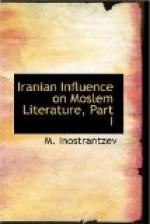[Sidenote: Occasional identity of Firdausi and Tabari.]
The story of Persia from the first mythical Kings to the last of the Sasanides exhibits in Tabari, as in allied Arabic works, a certain similarity of conception and presentation which leads to the assumption of an indigenous original work at least respecting a very large portion. Now the Shahnameh of the great poet Firdausi, a national epic of the kind which no other people possess, while it on one hand, apart from the poetic license indulged in by Firdausi, contains much that is either not found at all or is essentially differently related in Arab writers; on the other, considerably accords with those Arab annalists in the order, in the whole structure, and in the details of the narrative. Indeed the poet often reproduces almost the identical phraseology of the historian. But now since according to both tradition and internal grounds Firdausi’s bases were not Arabic books, the coincidence must be explained from a common ultimate source. The original work has been reflected to us in Tabari and other Arabs as well as Firdausi through a series of intermediate texts. To judge by the express statements and suggestions as also by various features in style and phraseology and further by all that we are aware of touching the circumstances of the literature we can say with certainty that, that original work like all other Persian narrative productions of the Sasanides and of the period of Arab conquest was composed in the written, language of this period, the Pahlavi. The most important connected presentment of Persian history in Pahlavi to which our reports go back is no doubt the Khoday Nameh, i.e., the “Book of Lords” a title which answers to the subsequent Shah Nameh or “Book of Kings.”
Hamza mentions that name. The prose introduction to Ferdausi says that the “Book of Kings” was written first of all at the instance of Khushrau I Anoshirwan, but that the complete story was compiled only under Yazdegerd III by the Dihkan Danishwar. This work which it would not be too bold to identify with the Koday Nameh began with the primeval king, Gayomarth, and reached down to the termination of the reign of Khushrau II, surnamed Parwez. Although this introduction to Ferdausi dates but from the fifteenth century, and as for details is disfigured by inaccuracies and fictions, I attach weight to what it indicates respecting the time of its composition. In fact the concord of the narrative in the various sources reaches down to the death of Parwez and then abruptly ceases; while there are no vestiges to demonstrate that the completion of the original work was brought about subsequent to the victory of the Arabs. And the legitimistic nature of the story Is especially in keeping with the times when usurpation and insurrections of all sorts had run their course, and when the people looked forward with, the inauguration of the rule of the youthful grandson, of Parwez, who was crowned




